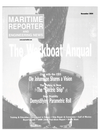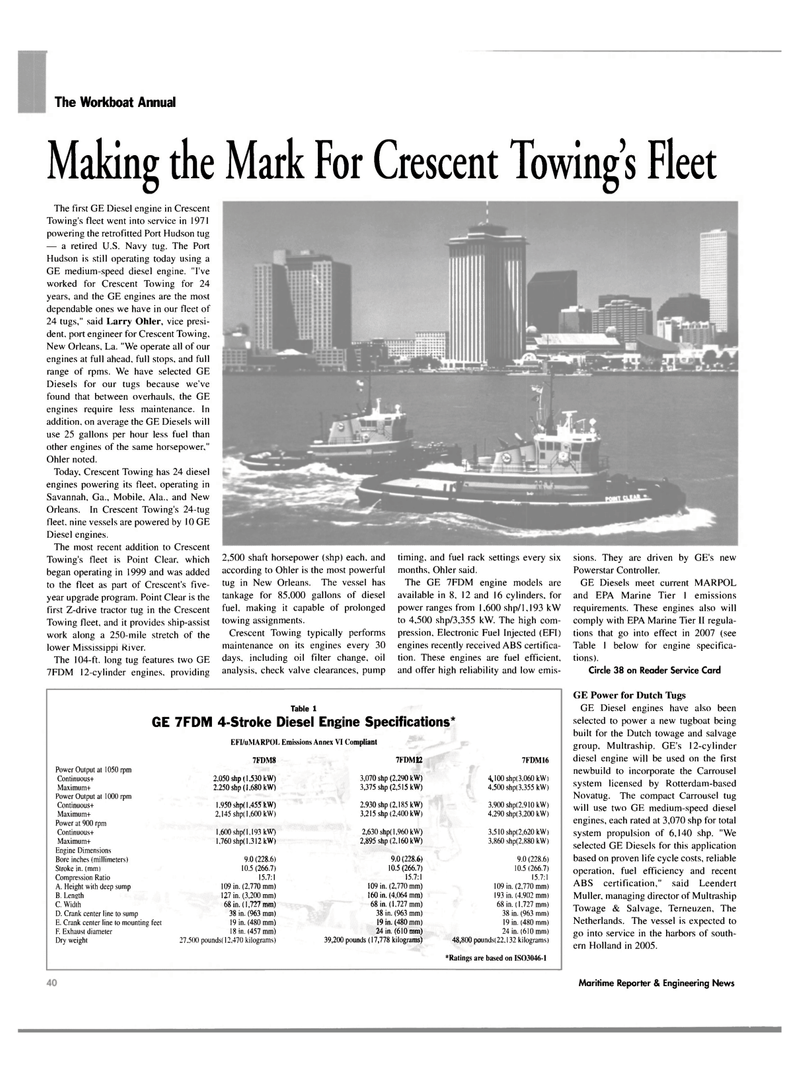
Page 38: of Maritime Reporter Magazine (November 2004)
The Workboat Annual
Read this page in Pdf, Flash or Html5 edition of November 2004 Maritime Reporter Magazine
The Workboat Annual
Making the Mark For Crescent Towing's Fleet
The first GE Diesel engine in Crescent
Towing's fleet went into service in 1971 powering the retrofitted Port Hudson tug — a retired U.S. Navy tug. The Port
Hudson is still operating today using a
GE medium-speed diesel engine. "I've worked for Crescent Towing for 24 years, and the GE engines are the most dependable ones we have in our fleet of 24 tugs," said Larry Ohler, vice presi- dent, port engineer for Crescent Towing,
New Orleans, La. "We operate all of our engines at full ahead, full stops, and full range of rpms. We have selected GE
Diesels for our tugs because we've found that between overhauls, the GE engines require less maintenance. In addition, on average the GE Diesels will use 25 gallons per hour less fuel than other engines of the same horsepower,"
Ohler noted.
Today, Crescent Towing has 24 diesel engines powering its fleet, operating in
Savannah, Ga., Mobile. Ala., and New
Orleans. In Crescent Towing's 24-tug fleet, nine vessels are powered by 10 GE
Diesel engines.
The most recent addition to Crescent
Towing's fleet is Point Clear, which began operating in 1999 and was added to the fleet as part of Crescent's five- year upgrade program. Point Clear is the first Z-drive tractor tug in the Crescent
Towing fleet, and it provides ship-assist work along a 250-mile stretch of the lower Mississippi River.
The 104-ft. long tug features two GE 7FDM 12-cylinder engines, providing 2,500 shaft horsepower (shp) each, and according to Ohler is the most powerful tug in New Orleans. The vessel has tankage for 85,000 gallons of diesel fuel, making it capable of prolonged towing assignments.
Crescent Towing typically performs maintenance on its engines every 30 days, including oil filter change, oil analysis, check valve clearances, pump timing, and fuel rack settings every six months, Ohler said.
The GE 7FDM engine models are available in 8, 12 and 16 cylinders, for power ranges from 1,600 shp/1,193 kW to 4,500 shp/3,355 kW. The high com- pression, Electronic Fuel Injected (EFI) engines recently received ABS certifica- tion. These engines are fuel efficient, and offer high reliability and low emis- sions. They are driven by GE's new
Powerstar Controller.
GE Diesels meet current MARPOL and EPA Marine Tier 1 emissions requirements. These engines also will comply with EPA Marine Tier II regula- tions that go into effect in 2007 (see
Table 1 below for engine specifica- tions).
Circle 38 on Reader Service Card
GE Power for Dutch Tugs
GE Diesel engines have also been selected to power a new tugboat being built for the Dutch towage and salvage group. Multraship. GE's 12-cylinder diesel engine will be used on the first newbuild to incorporate the Carrousel system licensed by Rotterdam-based
Novatug. The compact Carrousel tug will use two GE medium-speed diesel engines, each rated at 3,070 shp for total system propulsion of 6,140 shp. "We selected GE Diesels for this application based on proven life cycle costs, reliable operation, fuel efficiency and recent
ABS certification," said Leendert
Muller, managing director of Multraship
Towage & Salvage, Terneuzen, The
Netherlands. The vessel is expected to go into service in the harbors of south- ern Holland in 2005.
Table 1
GE 7FDM 4-Stroke Diesel Engine Specifications*
EFI/uMARPOL Emissions Annex VI Compliant 7FDM8 7FDM12 7FDM16
Power Output at 1050 rpm
Continuous+ 2,050 shp (1.530 kW) 3,070 shp (2,290 kW) 4,100 shp(3.060 kW)
Maximum+ 2.250 shp (1,680 kW) 3,375 shp (2,515 kW) 4,500 shp(3,355 kW)
Power Output at 1000 rpm
Continuous+ 1.950 shp( 1.455 kW) 2.930 shp (2,185 kW) 3.900 shp( 2.910kW)
Maximum+ 2,145 shp( 1,600 kW) 3,215 shp (2,400 kW) 4,290 shp(3,200 kW)
Power at 900 rpm
Continuous+ 1,600 shp( 1,193 kW) 2,630 shp( 1,960 kW) 3,510 shp(2,620 kW)
Maximum+ 1,760 shp( 1.312 kW) 2,895 shp (2.160 kW) 3,860 shp(2,880 kW)
Engine Dimensions
Bore inches (millimeters) 9.0 (228.6) 9.0 (228.4) 9.0(228.6)
Stroke in. (mm) 10.5 (266.7) 10.5(266.7) 10.5 (266.7)
Compression Ratio 15.7:1 15.7:1 15.7:1
A. Height with deep sump 109 in. (2.770 mm) 109 in. (2,770 mm) 109 in. (2,770 mm)
B. Length 127 in. (3,200 mm) 160 in. (4,064 mm) 193 in. (4,902 mm)
C. Width 68 in. (1,727 mm) 68 in. (1.727 mm) 68 in. (1.727 mm)
D. Crank center line to sump 38 in. (963 mm) 38 in. (963 mm) 38 in. (963 mm)
E. Crank center line to mounting feet 19 in. (480 mm) 19 in. (480 mm) 19 in. (480 mm)
F. Exhaust diameter 18 in. (457 mm) 24 in. (610 mm) 24 in. (610 mm)
Dry weight 27.500 pounds! 12,470 kilograms) 39,200 pounds (17,778 kilograms) 48,800pounds!22.132 kilograms) *Ratings are based on IS03046-1 40 Maritime Reporter & Engineering News

 37
37

 39
39
